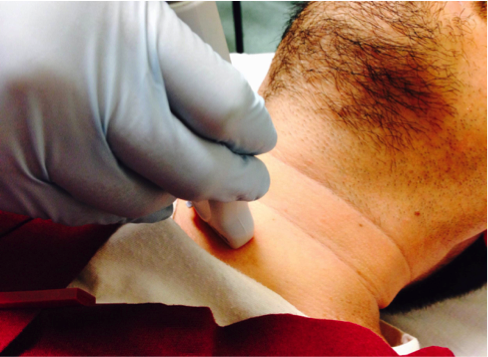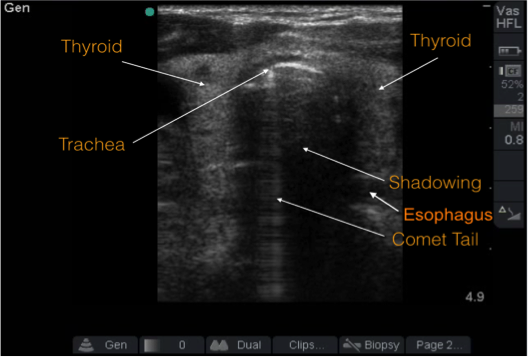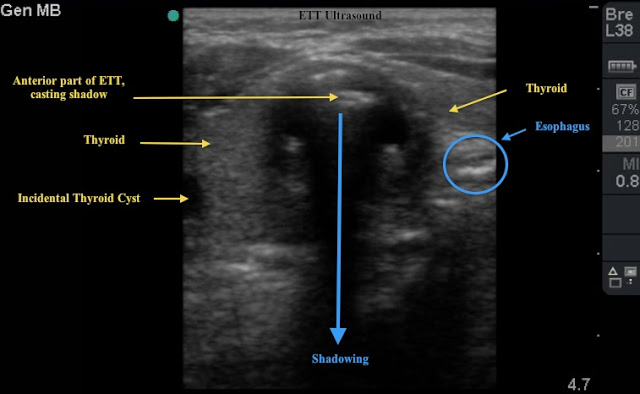“Trust, but verify”
-Ronald Reagan
Why would you need ultrasound for tube confirmation? You can confirm placement with direct visualization (sometimes video laryngoscopy), use end tidal CO2, look for color change on colorimetric capnography, listen for bilateral breath sounds, check pulse oximetry, and look for fogging in the tube. In most cases, these methods will be sufficient. However, it is possible that you do not get a definitive result with any of these as Dr. Alerhand points out (Alerhand 2016). In addition, none of these techniques is 100% specific, and as such, it is generally encouraged to confirm tube placement in at least two ways. Well, ultrasound is one more rapid way to confirm placement that you can add to your toolbox. The sensitivity and specificity of this test are both reported to be in the 90’s in a meta-analysis comprising 969 intubations over 11 studies (Das et al. 2015).
Let’s get right to the steps:
1. Place the linear probe in the transverse direction superior to the suprasternal notch.

2. Locate the trachea. The trachea will appear as a hyperechoic curvilinear structure with “comet tail” shadowing.
3. Locate the esophagus. The esophagus will be distal and lateral to the trachea. It will appear as a hyperechoic oval structure with a hypoechoic center.

4. Locate the endotracheal tube.
a. For successful endotracheal intubation, you should see a second hyperechoic curvilinear structure within the trachea. If you are having difficulty finding the tube, you may try gently shaking the tube and looking for movement with Doppler.

b. For accidental esophageal intubation, you will see the “double tract” sign. In this case, you will see your trachea as before, but distal and lateral to it, you will see another structure, which looks like a second trachea. The esophageal intubation will also similarly appear with “comet tail” shadowing.

In summary, ultrasound confirmation of endotracheal tube placement is another relatively quick approach to confirmation. In order to really excel at it, you will have to start scanning normal tube placements regularly to gain proficiency at recognizing the anatomical structures.
References
Abbasi, Saeed, et al. “Direct ultrasound methods: a confirmatory technique for proper endotracheal intubation in the emergency department.” European Journal of Emergency Medicine 22.1 (2015): 10-16.
Alerhand, Stephen. “Ultrasound for Confirmation of Endotracheal Tube Placement During CPR.” Emdocs, 18 Feb. 2016, www.emdocs.net/ultrasound-for-confirmation-of-endotracheal-tube-placement-during-cpr.
Chao, Alice, and Laleh Gharahbaghian. “Tips and Tricks: Airway Ultrasound.” Tips and Tricks: Airway Ultrasound // ACEP, www.acep.org/content.aspx?id=102309.
Chou, Eric H., et al. “Ultrasonography for confirmation of endotracheal tube placement: a systematic review and meta-analysis.” Resuscitation 90 (2015): 97-103.
Chou, Hao-Chang, et al. “Real-time tracheal ultrasonography for confirmation of endotracheal tube placement during cardiopulmonary resuscitation.” Resuscitation 84.12 (2013): 1708-1712.
Chou, Hao-Chang, et al. “Tracheal rapid ultrasound exam (TRUE) for confirming endotracheal tube placement during emergency intubation.” Resuscitation 82.10 (2011): 1279-1284.
Das, Saurabh Kumar, et al. “Transtracheal ultrasound for verification of endotracheal tube placement: a systematic review and meta-analysis.” Canadian Journal of Anesthesia/Journal canadien d’anesthésie 62.4 (2015): 413-423.
Drescher, Michael J., Frederick U. Conard, and Neil E. Schamban. “Identification and description of esophageal intubation using ultrasound.” Academic Emergency Medicine 7.6 (2000): 722-725.
Favot, Mark. “Ultrasound for Verification of Endotracheal Tube Location.” ALiEM, 2 Mar. 2015, www.aliem.com/2015/ultrasound-for-verification-of-endotracheal-tube-location.
Gottlieb, Michael, et al. “Accuracy of a novel ultrasound technique for confirmation of endotracheal intubation by expert and novice emergency physicians.” Western Journal of Emergency Medicine 15.7 (2014): 834.
Li, James. “Capnography alone is imperfect for endotracheal tube placement confirmation during emergency intubation.” The Journal of emergency medicine 20.3 (2001): 223-229.
Milling, Truman John, et al. “Transtracheal 2-d ultrasound for identification of esophageal intubation.” The Journal of emergency medicine 32.4 (2007): 409-414.
